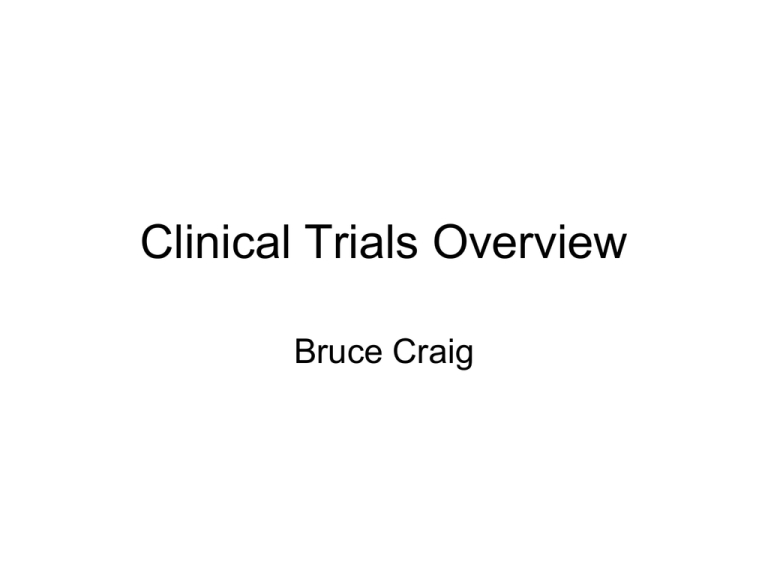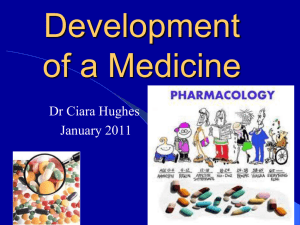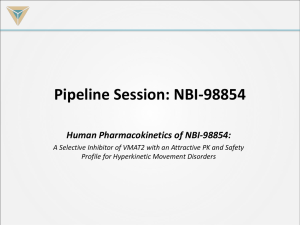Clinical Trials Overview
advertisement

Clinical Trials Overview
Bruce Craig
Clinical Trials
• A clinical trial : prospectively planned
experiment for the purpose of evaluating
potentially beneficial therapies or treatments
• In general, these studies are conducted
under as many controlled conditions as
possible so that they provide definitive
answers to pre-determined, well-defined
questions
Primary vs. Secondary Questions
• Primary
– most important (i.e., central question)
– ideally, only one
– stated in advance
– basis for design and sample size calcs
• Secondary
– related to primary
– also stated in advance
– limited in number but usually more than 1
Examples
• Physicians Health Study (PHS) (phs.bwh.harvard.edu/phs1.htm)
– risks and benefits of aspirin and beta carotene in the
prevention of cardiovascular disease and cancer
– started recruitment of US male physicians in 1981
– conducted entirely by mail (much cheaper!!)
– 2x2 factorial structure
– Primary endpoint: total mortality
– Secondary endpoint: myocardial infarction
Examples
• Eastern Cooperative Oncology Group (ECOG)
–
–
–
–
–
Information available at ecog.dfci.harvard.edu
multicenter cancer clinical trial
Elderly women with stage II breast cancer
tamoxifen vs placebo
primary: tumor recurrence/relapse, disease-free
survival
– secondary: total mortality
Definitions
• Single Blind Study: A clinical trial where
the participant does not know the identity
of the treatment received
• Double Blind Study: A clinical trial in
which neither the patient nor the treating
investigators know the identity of the
treatment being administered.
Definitions
• Placebo:
– Used as a control treatment
1. An inert substance made up to physically
resemble a treatment being investigated
2. Best standard of care if “placebo” unethical
3. “Sham control”
Definitions
• Adverse event:
– An incident in which harm resulted to a
person receiving health care.
– Examples: Death, irreversible damage to
liver, nausea
– Not always easy to specify in advance
because many variables will be measured
– May be known adverse effects from earlier
trials
Adverse Events
• Challenges
– Long term follow-up versus early benefit
– Rare AEs may be seen only with very large
numbers of exposed patients and/or long term
follow-up
• Example – COX II inhibitors
– Vioxx & Celebrex
– Immediate pain reduction versus longer term
increase in cardiovascular risk
Surrogate Endpoints
• Response variables used to address
questions often called endpoints
• Surrogates used as alternative to desired or
ideal clinical response to save time and/or
resources
• Examples
– Suppression of arrhythmia (sudden death)
– T4 cell counts (AIDS or ARC)
– Cholesterol (heart disease)
• Often used in therapeutic exploratory trials
• Use with caution in confirmatory trials
The General Flow of
Statistical Inference
Patient
Population
Sample
Protocol to
Obtain
Participants
Observed
Results
Inference about Population
Sample protocol / design key to analysis and inference and
may redefine the population for future experiment
Types of Clinical Trials
• Randomized
• Non-Randomized
• Single-Center
• Multi-Center
• Phase I, II, III, IV Trials
Phase I Trial
• Objective : To determine an acceptable
range of doses and schedules for a new
drug
• Usually seeking maximum tolerated dose
• Participants often those that have failed
other treatments
• Important, however, that they still have
“normal” organ functions
Phase II Trial
• Objective: To determine if new drug has
any beneficial activity and thus worthy of
further testing / investment of resources.
• Doses and schedules may not be optimum
• Begin to focus on population for whom this
drug will likely show favorable effect
Phase III Trial
• Objective : To compare experimental or
new therapies with standard therapy or
competitive therapies.
• Very large, expensive studies
• Required by FDA for drug approval
• If drug approved, usually followed by
Phase IV trials to follow-up on long-range
adverse events – concern is safety
Characterization of Trials
Phase
Single Center
Multi Center
Randomized Non-Rand. Randomized Non-Rand.
I
Never
Yes
Never
Sometimes
II
Rare
Yes
Yes
Sometimes
III
Yes
Use of
Historical
Controls
Yes
Use of
Historical
Controls
Carrying out a multi-center randomized clinical trial is the most difficult
way to generate scientific information.
Why Clinical Trials?
1. Most definitive method to determine
whether a treatment is effective.
– Other designs have more potential
biases
– One cannot determine in an
uncontrolled setting whether an
intervention has made a difference in
the outcome.
– Correlation versus causation
Examples of False Positives
1.High cholesterol diet and rectal cancer
2.Smoking and breast cancer
3.Vasectomy and prostate cancer
4.Red meat and colon cancer
5.Red meat and breast cancer
6.Drinking water frequently and bladder cancer
7.Not consuming olive oil and breast cancer
Replication of observational studies may not
overcome confounding and bias
Why Clinical Trials?
2. Help determine incidence of side
effects and complications.
Example: Coronary Drug Project - for patients with
documented MI, does taking lipid modifying drugs
reduce mortality?
A. Detection of side effect (other arrhythmias)
Clofibrate 33.3%
Niacin
32.7%
p<.05
Placebo
28.2%
B. Natural occurring side effect (nausea)
Clofibrate 7.6%
Placebo
6.2%
p>.05
Why Clinical Trials?
3.Theory not always best path
• Intermittent positive pressure breathing
(IPPB) reduced use, no benefit
• High [O2] in premature infants
Retrolental Fibroplasia, Harmful
• Tonsillectomy Reduced use
• Bypass Surgery Restricted use
Phase I Design Strategy
• Designs based largely on tradition
• Typically do some sort of dose escalation
to reach maximum tolerated dose (MTD)
• Has been shown to be safe and
reasonably effective
• Dose escalation often based on Fibonacci
series
– 1 2 3 5 8 13 . . . .
Dose-response curve
-animal study-
Typical Scheme
1. Enter 3 patients at a given dose
2. If no toxicity, go to next dosage and repeat
step 1
3. a. If 1 patient has serious toxicity, add 3 more
patients at that does (go to 4)
b. If 2/3 have serious toxicity, consider MTD
4. a. If 2 or more of 6 patients have toxicity,
MTD reached
b. If 1 of 6 has toxicity, increase dose and go
back to step 1
Summary of Schemes
(Storer, Biometrics 45:925-37, 1989)
A. “Standard”
– Observe group of 3 patients
– No toxicity increase dose
– Any toxicity observe 3 or more
• One toxicity out of 6 increase dose
• Two or more toxicity stop
B. “1 Up, 1 Down”
– Observe single patients
– No toxicity increase dose
– Toxicity decrease dose
Summary of Schemes
(Storer, Biometrics 45:925-37, 1989)
C. “2 Up, 1 Down”
– Observe single patients
– No toxicity in two consecutive increase
dose
– Toxicity decrease dose
D. “Extended Standard”
– Observe groups of 3 patients
– No toxicity increase dose
– One toxicity dose unchanged
– Two or three toxicity decrease dose
Summary of Schemes
(Storer, Biometrics 45:925-37, 1989)
E. “2 Up, 2 Down”
– Observe groups of 2 patients
– No toxicity increase dose
– One toxicity dose unchanged
– Both toxicity decrease dose
B, C, D, E - fixed sample sizes ranging from 12 to 32
patients
Can speed up process to get to target dose range
F. Bayesian sequential/adaptive designs
Phase II Designs
References:
Gehan (1961) Journal of Chronic Disorders
Fleming (1982) Biometrics
Storer (1989) Statistics in Medicine
• Goal
–
–
–
–
Screen for therapeutic activity
Further evaluate toxicity
Test using MTD from Phase I
If drug passes screen, test further
Phase II Design
• Design of Gehan
– No control (is this wise?)
– Two-stage (double sampling)
– Goal is to reject ineffective drugs ASAP
Decision I:
Drug is unlikely to be effective
in x% of patients
Decision II:
Drug could be effective
in x% of patients
Phase II Design
• Example: Gehan Design
– Let x% = 20% : want to check if drug likely to
work in at least 20% of patients
1. Enter 14 patients
2. If 0/14 responds, stop and
declare true drug response 20%
3. If 1+/14 respond, add 15-40
more patients
4. Estimate response rate & C.I.
Gehan Design
• Why 14 patients initially?
Patient
1
2
3
--8
--14
Prob
0.8
0.64 (0.8 x 0.8)
0.512 (0.8 x 0.8 x 0.8)
--0.16
--0.044
• If drug 20% effective, there would be
~95.6% chance of at least one success
• If 0/14 success observed, reject drug
Phase II Design
• Stage I Sample Size - Gehan
Table I
Rejection
Error
5
5%
59
10%
45
Effectiveness (%)
10 15 20 25 40
29 19 14 11 6
22 15 11
9 5
50
5
4
Stage II Sample Size
• Based on desired precision of effectiveness estimate
r1 = # of successes in Stage 1
n1= # of patients in Stage 1
With pˆ1 r1 / n1 , SE(ˆp1 )
ˆp1 (1 ˆp1 )
n1
• Now precision of total sample N=(n1 + n2)
ˆ* p
ˆ1 then
If p
SE (pˆ * )
pˆ * (1 pˆ * )
N
Stage II Sample Size
To be conservative, Gehan suggested
pˆ pˆ1 1.15SE( pˆ1 )
*
The upper 75% confidence limit from first sample
• Thus, we can generate a table for size of
second stage (n2) based on desired precision
Additional Patients for Stage II
(n2, a1=.05)
Required
Precision
(SE)
Number of
Successes
Stage I
Therapeutic Effectiveness (%)
5
10
15
20
25
30
r1 / n1
59
29
19
14
11
9
+1 SE
1
0
4
30
45
60
70
5%
2
0
17
45
63
78
87
3
0
28
58
76
87
91
4
0
38
67
83
89
91
5
0
46
75
86
89
91
1
0
0
0
1
7
11
2
0
0
0
6
12
15
3
0
0
1
9
14
16
4
0
0
3
11
14
16
5
0
0
5
11
14
16
+1 SE
10%
Phase II Trial Designs
• Many cancer Phase II trials follow Gehan design
• Many other diseases could – there seems to be
no standard non-cancer Phase II design
• Might also randomize patients into multiple arms
each with a different dose – can then get a dose
response curve
• Other two-stage designs based on determining
p1-p0 > x% where p0 is the standard care
combination
Phase III Trial Designs
• The foundation for the design of controlled
experiments established for agricultural experiments
• The need for control groups in clinical studies
recognized, but not widely accepted until 1950s
• No comparison groups needed when results dramatic:
– Penicillin for pneumococcal pneumonia
– Rabies vaccine
• Use of proper control group necessary due to:
– Natural history of most diseases
– Variability of a patient's response to intervention
Phase III Design
• Comparative Studies
• Experimental Group vs. Control Group
• Establishing a Control
1. Historical
2. Concurrent
3. Randomized
• Randomized Control Trial (RCT) is the gold
standard
– Eliminates several sources of bias
Purpose of Control Group
• To allow discrimination of patient
outcomes caused by test treatment from
those caused by other factors
– Natural progression of disease
– Observer/patient expectations
– Other treatment
• Fair comparisons
– Necessary to be informative
Goals of Phase III
Clinical Trial
• Superiority Trials
– A controlled trial may demonstrate
efficacy of the test treatment by
showing that it is superior to the control
• No treatment
• Best standard of care
Goals of Phase III
Clinical Trials
• Non-Inferiority Trials
– Controlled trial may demonstrate efficacy by
showing the test treatment is similar in efficacy
to a known effective treatment
• The active control has to be effective under the
conditions of the trials
• New treatment cannot be worse by a pre-specified
amount
• New treatment may not be better than the standard
but may have other advantages
– Cost
– Toxicity
– Invasiveness
Significance of Control Group
•
•
•
•
•
•
•
•
Inference drawn from the trial
Ethical acceptability of the trial
Degree to which bias is minimized
Type of subjects
Kind of endpoints that can be studied
Credibility of the results
Acceptability of the results by regulatory authorities
Other features of the trial, its conduct, and
interpretation
Use of Placebo Control
• The “placebo effect” is well documented
• Could be
– No treatment + placebo
– Standard care + placebo
• Matched placebos are necessary so patients and
investigators cannot decode the treatment
assignment
• E.g. Vitamin C trial for common cold
– Placebo was used, but was distinguishable
– Many on placebo dropped out of study – not
blinded
– Those who knew they were on vitamin C
reported fewer cold symptoms and duration
than those on vitamin who didn't know
Unbiased Evaluation
Subject Bias (NIH Cold Study)
(Karlowski, 1975)
Duration of Cold (Days)
Blinded
Unblinded
Subjects
Subjects
Placebo
6.3
8.6
Ascorbic Acid
6.5
4.8
Historical Control Study
• A new treatment used in a series of subjects
• Outcome compared with previous series of
comparable subjects
• Non-randomized
• Rapid, inexpensive, good for initial testing of new
treatments
• Vulnerable to biases
Different underlying populations
Criteria for selecting patients
Patient care
Diagnostic or evaluating criteria
Randomized Control
Clinical Trial
• Reference: Byar et al. (1976)
New England Journal of Medicine
• Patients assigned at random to either
treatment(s) or control
• Considered to be “Gold Standard”
Disadvantages of Randomized
Control Clinical Trial
1. Generalizable Results?
– Subjects may not represent general
patient population – volunteer effect
2. Recruitment
– Twice as many new patients
3. Acceptability of Randomization Process
– Some physicians will refuse
– Some patients will refuse
4. Administrative Complexity
Ethics of Randomization
• Statistician/clinical trialist must sell benefits of randomization
• Ethics MD should do what he thinks is best for his patient
– Two MD's might ethically treat same patient quite differently
• Chalmers & Shaw (1970) Annals New York Academy of
Science
1.
2.
If MD "knows" best treatment, should not participate in trial
If in doubt, randomization gives each patient equal chance to
receive one of therapies (i.e. best)
3. More ethical way of practicing medicine
• Bayesian Adaptive designs More likely assign “better” treatment
Comparing Treatments
• Fundamental principle
• Groups must be alike in all important aspects and only differ in the
treatment each group receives
• In practical terms, “comparable treatment groups” means
“alike on the average”
• Randomization
• Each patient has the same chance of receiving any of the
treatments under study
• Allocation of treatments to participants is carried out using a
chance mechanism so that neither the patient nor the physician
know in advance which therapy will be assigned
• Blinding
• Avoidance of psychological influence
• Fair evaluation of outcomes
Randomized Phase III
Experimental Designs
Assume:
• Patients enrolled in trial have satisfied eligibility
criteria and have given consent
• Balanced randomization: each treatment group will
be assigned an equal number of patients
Issue
• Different experimental designs can be used to
answer different therapeutic questions
Commonly Used Phase III
Designs
•
•
•
•
•
•
•
•
•
Parallel
Withdrawal
Group/Cluster
Randomized Consent
Cross Over
Factorial
Large Simple
Equivalence/Non-inferiority
Sequential
Parallel Design
Screen
Trt A
Randomize -
Trt B
• H0: A vs. B
• Advantage
– Simple, General Use
– Valid Comparison
• Disadvantage
– Few Questions/Study
Fundamental Design
Eligible
Yes
Consent
No
No
Dropped
Dropped
Yes
R
A
N
D
O
M
I
Z
E
Comment: Compare A with B
A
B
Run-In Design
Problem:
• Non-compliance by patient may seriously impair
efficiency and possibly distort conclusions
Possible Solution: Drug Trials
• Assign all eligible patients a placebo to be taken
for a “brief” period of time. Patients who are
“judged” compliant are enrolled into the study.
This is often referred to as the “Placebo Run-In”
period.
• Can also use active drug to test for compliance
Run-In Design
Screen &
Consent
R
A
Run-In
Satisfactory N
Period
D
O
M
I
Unsatisfactory
Z
E
Dropped
Note: It is assumed that all patient entering the run-in
period are eligible and have given consent
A
B
Withdrawl Study
I
Trt A
II
Not Trt A
Trt A -
• H0: How long should TRT A continue?
• Advantage
–Easy Access to Subjects
–Show continued Trt Beneficial
• Disadvantage
–Selected Population
–Different Disease Stage
Cluster Randomization Designs
• Groups (clinics, communities) are randomized to treatment or control
• Examples:
• Community trials on fluoridization of water
• Breast self examination programs in different clinic setting in USSR
• Smoking cessation intervention trial in different school district
in the state of Washington
• Advantages
• Sometimes logistically more feasible
• Avoid contamination
• Allow mass intervention, thus “public health trial”
• Disadvantages
• Effective sample size less than number of subjects
• Many units must participate to overcome unit-to-unit variation,
thus requires larger sample size
• Need cluster sampling methods
Cross Over Design
H0: A vs. B
Scheme
Period
AB
BA
Group
I
II
1
2
TRT A
TRT B
TRT B
TRT A
• Advantage
– Each patient their own control
– Smaller sample size
• Disadvantage
– Not useful for acute disease
– Disease must be stable
– Assumes no period carry over
– If carryover, have a study half sized
(Period I A vs. Period I B)
Superiority vs.
Non-Inferiority Trials
Superiority Design: Show that new treatment is
better than the control or standard (maybe a
placebo)
Non-inferiority: Show that the new treatment
a) Is not worse that the standard by more than some
margin
b) Would have beaten placebo if a placebo arm had
been included (regulatory)
Equivalence/Non-inferiority Trial
• Trial with active (positive) controls
• The question is whether new (easier or cheaper)
treatment is as good as the current treatment
• Must specify margin of “equivalence” or non-inferiority
• Can't statistically prove equivalency -- only show that
difference is less than something with specified
probability
• Historical evidence of sensitivity to treatment
• Sample size issues are crucial
• Small sample size, leading to low power and
subsequently lack of significant difference, does not
imply “equivalence”
Non-Inferiority Challenges
• Requires high quality trial
• Poor execution favors non-inferiority
• Treatment margin somewhat arbitrary
Sequential Design
• Continue to randomize subjects until H0 is
either rejected or “accepted”
• A large statistical literature for classical
sequential designs
• Developed for industrial setting
• Modified for clinical trials
(e.g. Armitage 1975, Sequential Medical Trials)
Classical Sequential Design
• Continue to randomize subjects until H0 is either rejected or “accepted”
• Classic
Trt Better
Net
20
Trt
0
Effect
Continue
“Accept” H0
-20
Continue
Trt Worse
100
200
300
No. of Paired Observations
Sample Size Considerations
Comparing Time to Event
Distributions
• Primary endpoint is the time to an event
• Compare the survival distributions
• Measure of treatment effect is the ratio of
the hazard rates
• Must also consider the length of follow-up
Exponential
Survival Distributions
• Surivival
function : P(T > t) = e-t
H0 : 2 = 1
1
Ha: 2 1
1
2 1
2 1
•George & Desu (1974)
N
2( Za Z ) 2
[ln(c / I )]2
•Assumes all patients followed to an event (no
censoring)
•Assumes all patients immediately entered
Converting Number of Events (D)
to Required Sample Size (2N)
• d = 2N x P(event)
2N = d/P(event)
• P(event) is a function of the length of total followup at time of analysis and the average hazard rate
• Let AR = accrual rate (patients per year)
A = period of uniform accrual (2N = AR x A)
F = period of follow-up after accrual complete
A/2 + F = average total follow-up at planned analysis
= average hazard rate
• Then P(event) = 1 – P(no event) = 1 Exp( ( A / 2 F ))
Time to Failure
• In many clinical trials
1. Not all patients are followed to an event
(i.e. censoring)
2. Patients are recruited over some period of time
(i.e. staggered entry)
• More General Model (Lachin, 1981)
N
where ….
( za z ) 2{g (C ) g (I )}
(C I ) 2
1. Instant Recruitment Study Censored At Time T
g ( )
2
1 e T
2. Continuous Recruiting (O,T) & Censored at T
g ( )
3T
(T 1 e T )
3. Recruitment (O, T0) & Study Censored at T (T > T0)
g ( )
2
1
e (T T0 ) e T
T0
Example
Assume a = .05 (2-sided) & 1 - = .90
C = .3
and
I = .2
T = 5 years follow-up
T0 = 3
0.
No Censoring, Instant Recruiting
N = 128
1.
Censoring at T, Instant Recruiting
N = 188
2.
Censoring at T, Continual Recruitment
N = 310
3.
Censoring at T, Recruitment to T0
N = 233
Sample Size Adjustment
for Non-Compliance
• References:
1.
2.
3.
Shork & Remington (1967) Journal of Chronic Disease
Halperin et al (1968) Journal of Chronic Disease
Wu, Fisher & DeMets (1988) Controlled Clinical Trials
• Problem
Some patients may not adhere to treatment protocol
• Impact
Dilute whatever true treatment effect exists
Sample Size Adjustment
for Non-Compliance
• Fundamental Principle
Analyze All Subjects Randomized
• Called Intent-to-Treat (ITT) Principle
– Noncompliance will dilute treatment effect
• A Solution
Adjust sample size to compensate for dilution effect
(reduced power)
• Definitions of Noncompliance
– Dropout: Patient in treatment group stops taking
therapy
– Dropin: Patient in control group starts taking
experimental therapy
Comparing Two Proportions
– Assumes event rates will be altered by
non-compliance
– Define
PT* = adjusted treatment group rate
PC* = adjusted control group rate
If PT < PC,
1.0
0
PC
PT
PT *
PC *
Adjusted Sample Size
Simple Model Compute unadjusted N
– Assume no dropins
– Assume dropout proportion R
– Thus PC* = PC
PT* = (1-R) PT + R PC
– Then adjust N
N*
– Example
R
.1
.25
N
(1 R) 2
1/(1-R)2
1.23
1.78
% Increase
23%
78%
Sample Size Adjustment
for Non-Compliance
Dropouts & dropins (R0, RI)
N
N*
(1 R0 RI ) 2
– Example
R0
.1
.25
R1
.1
.25
1/(1- R0- R1)2
1.56
4.0
% Increase
56%
4 times%
Sample Size Adjustments
• More Complex Model
Ref: Wu, Fisher, DeMets (1980)
• Further Assumptions
–
–
–
–
–
Length of follow-up divided into intervals
Hazard rate may vary
Dropout rate may vary
Dropin rate may vary
Lag in time for treatment to be fully effective
Sample Size Summary
• Ethically, the size of the study must be
large enough to achieve the stated goals
with reasonable probability (power)
• Sample size estimates are only
approximate due to uncertainty in
assumptions
• Need to be conservative but realistic










